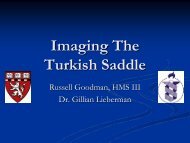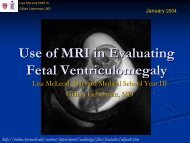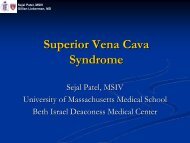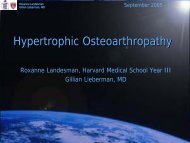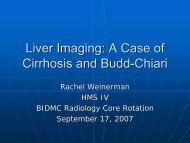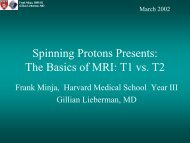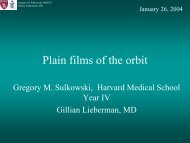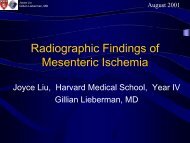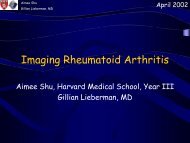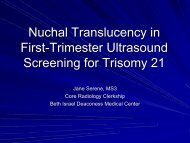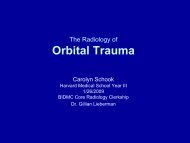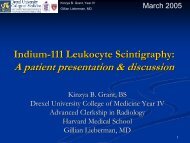Gardner's Syndrome - Lieberman's eRadiology Learning Sites
Gardner's Syndrome - Lieberman's eRadiology Learning Sites
Gardner's Syndrome - Lieberman's eRadiology Learning Sites
Create successful ePaper yourself
Turn your PDF publications into a flip-book with our unique Google optimized e-Paper software.
Patient Report & Review of Radiologic Features<br />
Pauline Mulleady, BUSM IV<br />
Gillian Lieberman, MD<br />
November 2008
Patient Report: Ms. CB<br />
Chief Complaint<br />
Weight loss >13 lbs in one month<br />
HPI<br />
38 year old woman with <strong>Gardner's</strong> <strong>Syndrome</strong><br />
(diagnosed at age 23) and s/p colectomy (1985) and<br />
multiple other small bowel resections secondary to<br />
desmoid tumors , now with weight loss.<br />
Today on monthly clinic visit, patient weighed in at<br />
93lbs, down 13lbs from her prior visit. She tries to<br />
drink 2‐4 cans of Ensure daily but is often unable to<br />
meet her goal due to early satiety. She also endures<br />
abdominal pain, n/v, and increased abdominal girth.
Ms. CB (cont’d)<br />
PMH<br />
<strong>Gardner's</strong> syndrome,<br />
s/p colectomy,<br />
s/p mutiple small bowel resections<br />
Small bowel adenocarcinoma<br />
s/p dermoid cyst removal (Left ovary)<br />
DVT, PE 2001<br />
Family History<br />
Father & 6/8 siblings with <strong>Gardner's</strong> syndrome .<br />
Father died at age 42 from polyp blocking pancreatic<br />
duct.<br />
Sister diagnosed with Gardner’s when attempting to<br />
enter marines, led to genetic testing of whole family
What is Gardner’s<br />
<strong>Syndrome</strong>?
Background<br />
In the early 1950s, Dr. Eldon Gardner described<br />
a family displaying not only the intestinal<br />
signs typical of familial adenomatous<br />
polyposis (FAP), but also a number of extra‐<br />
intestinal lesions such as osteomas,<br />
epidermal cysts, desmoid tumors, etc.<br />
This combination of FAP‐like colonic<br />
adenomatosis and extra‐colonic lesions came<br />
to be known as Gardner’s <strong>Syndrome</strong>.
Intestinal Lesions<br />
Familial Adenomatous Polyposis<br />
characterized by thousands of<br />
colonic adenomatous polyps<br />
extending from the stomach,<br />
duodenum, and colon.<br />
Incidence is approximately 1 case<br />
in 8000<br />
Chance of malignant<br />
transformation to colon cancer is<br />
100% without surgical<br />
intervention.<br />
The University of Utah Eccles Health Sciences Library [3]<br />
http://library.med.utah.edu/WebPath/GIHTML/GI143.html
Genetics<br />
It is now known that an autosomal<br />
dominant genetic disorder mutation<br />
in the adenomatous polyposis coli<br />
(APC) gene, the same gene<br />
responsible for FAP, is responsible for<br />
Gardner’s <strong>Syndrome</strong> (GS) [1].<br />
The extraintestinal signs of GS have<br />
been found in 20% of patients with<br />
FAP [2].<br />
Gardner’s syndrome is generally<br />
considered a variant of FAP, possibly<br />
representing variable penetrance.
ExtraIntestinal Lesions<br />
Osteomas and dental abnormalities<br />
Desmoid tumors<br />
Cutaneous lesions<br />
Congenital hypertrophy of the retinal<br />
pigment epithelium<br />
Adrenal adenomas
Osteomas & Dental<br />
Abnormalities<br />
Skeletal abnormalities are seen in approximately 90% of<br />
patients with GS [4]<br />
Osteomas<br />
most common abnormality. Osteomas precede clinical<br />
and radiologic evidence of colonic polyposis; therefore,<br />
they may be sensitive markers for the disease.<br />
<strong>Sites</strong> include:<br />
outer cortex of the skull,<br />
paranasal sinuses and the mandible [4]<br />
May occur in long bones, but less frequently<br />
Dental abnormalities<br />
Supernumerary teeth, compound odontomas and/or impacted<br />
teeth were seen in 30% of the patients with this disease
Osteoma: Radiographic<br />
Detection (Companion Pt #1)<br />
Fonseca, LC. Dentomaxillofac Radiol [6]<br />
Dental panoramic radiography may be useful for early detection of GS, as<br />
osteomas (arrows) & dental abnormalities not apparent on physical examination<br />
can be detected on routine radiographs in up to 90 percent of FAP patients [5].
Osteoma: CT Detection (Companion Pt<br />
#2)<br />
However, given the<br />
bidimensional imaging<br />
quality and<br />
superimposition of bony<br />
structures seen with<br />
panradiography, CT is<br />
superior for localizing and<br />
assessing the extent of<br />
tumor mass.[6]<br />
Shown here:<br />
Plain films: well‐defined osteo‐sclerotic<br />
lesion, with lobulated margins involving<br />
the frontal & ethmoidal air sinuses<br />
CT Scan: intra‐cranial & extra dural<br />
extension of the osteoma with<br />
compression of the brain parenchyma<br />
anteriorly. Incidentally, the brain<br />
parenchyma was normal & did not show<br />
any focal area of abnormal attenuation.<br />
Plain films<br />
Axial CT<br />
Dr.Anand Gaikwad http://www.kem.edu/dept/radiology/case51_03.htm [7]
Desmoid tumors‐<br />
General Info<br />
The term desmoid is derived from the Greek word<br />
desmos, which means “tendonlike.”<br />
Desmoid tumors often appear as infiltrative, usually well‐<br />
differentiated, poorly circumscribed fibrous neoplasms<br />
originating from the musculoaponeurotic structures .<br />
They are also known as “aggressive fibromatosis,” a<br />
tribute to their aggressive local behavior. However, they<br />
are considered benign as they do not metastasize.<br />
In the general population, desmoid tumors arise most<br />
commonly from the rectus abdominis muscle in<br />
postpartum women or from abdominal surgery scars [8].
Desmoid tumor‐ Microscopic<br />
Shown here: a poorly<br />
circumscribed<br />
proliferation of spindle<br />
cells (fibroblast‐like) of<br />
uniform appearance and<br />
separated from one<br />
another by dense bands<br />
of collagen . The lesion<br />
(*) has infiltrated<br />
adipose tissue (arrow)<br />
and skeletal muscle (M).<br />
The tumors tend to<br />
infiltrate adjacent<br />
muscle bundles,<br />
frequently entrapping<br />
them and causing their<br />
degeneration.<br />
Dinauer, P. A. et al. Radiographics<br />
2007;27:173-187
Desmoid Tumor‐ Macroscopic<br />
Tumors range from<br />
5‐20 cm in diameter<br />
and have a firm,<br />
gritty texture. The<br />
cut surface reveals<br />
a glistening white ,<br />
trabeculated tissue.<br />
The tumors lack a<br />
true capsule.<br />
Dinauer, P. A. et al. Radiographics 2007;27:173-187
Desmoid Tumor‐ Differential<br />
There are no specific<br />
imaging features to<br />
distinguish desmoid<br />
tumors from other solid<br />
masses. Thus, the<br />
diagnosis of desmoid<br />
tumor should be<br />
considered in patients<br />
with an abdominal<br />
mass, a history of<br />
abdominal surgery or<br />
injury, or Gardner<br />
syndrome.<br />
Differential Diagnosis of Desmoid Tumors<br />
Malignant Fibrosarcoma, rhabdomyosarcoma<br />
synoviosarcoma, liposarcoma, fibrous<br />
histiocytoma,<br />
lymphoma, and metastases<br />
Benign Neurofibroma, neuroma, and leiomyomas<br />
Hematoma Rectus sheath, chest wall, mesentery,<br />
retroperitoneum<br />
Adapted from Casillas, J. RadioGraphics 1991 11: 959-968
Desmoid Tumors‐ Gardner’s<br />
<strong>Syndrome</strong><br />
Peak incidence of desmoid tumor in GS is between 28 and 31<br />
years [1]<br />
About ½of abdominal desmoids occur intra‐abdominally<br />
while the other 1/2 are found in tissues of the abdominal wall<br />
Mesentenic desmoids tend to develop 1 or 2 years after<br />
resection of the intestinal tract. They may even be<br />
accompanied by an anterior abdominal wall tumor arising<br />
from the surgical scar.<br />
However, a few have been noted to arise before surgery and<br />
even before the onset of polyposis [1].<br />
Clinically, desmoids may be asymptomatic or may cause<br />
pain or intestinal obstruction as a result of impingement.
Desmoid Tumor‐ Imaging<br />
Ultrasound<br />
variable echogenicity, with smooth, well‐<br />
defined margins.<br />
CT<br />
On contrast‐enhanced scans, the tumors are<br />
generally high attenuation (relative to muscle)<br />
& may have well‐defined margins.<br />
MRI<br />
T1: low signal intensity relative to muscle and<br />
T2: variable signal intensity on T2‐weight
Our Patient: CB<br />
I+ Axial CT<br />
PACS BIDMC<br />
I+ Sagittal CT<br />
PACS BIDMC<br />
Enhancing ST density material extends diffusely along the intra‐abdominal<br />
mesentery, tethering the SB loops. Within the right anterior abdominal wall,<br />
there is an 8.6 x 4.2 cm heterogeneously‐enhancing ST mass measuring 8.6 x<br />
4.2 cm. The proximal loops of SB are dilated, with multiple air‐fluid levels.
Desmoid Tumor:MRI (Companion Pt<br />
#3)<br />
A B<br />
Dinauer, P. A. et al. Radiographics 2007;27:173-187<br />
Axial T2 MRI<br />
C+ Sagittal T1 MRI<br />
(a) Axial T2‐weighted image shows a large heterogeneous mass (arrow) in the<br />
left abdominal wall containing regions of intermediate to low signal intensity.<br />
(b) Sagittal gadolinium‐enhanced T1‐weighted image shows an enhancing<br />
tumor (arrow) that involves fascial layers of the left rectus abdominis muscle.
Our Patient‐ CB<br />
CTA 3D Reconstruction<br />
PACS BIDMC<br />
C+ Axial CT<br />
PACS BIDMC<br />
The main morbidity & mortality of desmoid tumors is due to their ability to<br />
engulf & eventually strangle blood vessels, nerves, ureters, & small bowel.<br />
Mortality is as high as 10 to 50 percent in patients who have a desmoid<br />
tumor [1]. However, progression is often gradual and the 10 year survival<br />
rate is 63 % [1].
EXTRA‐COLONIC MALIGNANCIES<br />
Thyroid (12 percent)<br />
Duodenal and periampullary (3 to 5 percent)<br />
Pancreatic (2 percent)<br />
Gastric (0.6 percent)<br />
Central nervous system (
Thyroid cancers<br />
The mean age of diagnosis is 33 years [1].<br />
The thyroid should probably be subject to physical examination<br />
and ultrasound annually, starting at age 10 to 12 years [1] .<br />
UltraSound<br />
Blum, M. http://uptodateonline.com/online/content/topic.do?topicKey=thyroid/22414<br />
Top panel: A sonogram of the left lobe of the thyroid<br />
gland that shows a hypoechoic nodule that is<br />
surrounded by a "halo."<br />
Lower panel: Doppler image shows that the "halo" is<br />
vascular.<br />
N: nodule; L: thyroid lobe
Summary<br />
The follow‐up and management of patients<br />
with <strong>Gardner's</strong> syndrome requires a<br />
collaboration of gastroenterologists, general<br />
surgeons, oral surgeons, radiologists,<br />
endocrinologists, neurologists,<br />
ophthalmologists, and dermatologists.<br />
Radiologists are in a unique position to<br />
initially diagnose this disorder.
Acknowledgements<br />
Jay Catena, MD
References<br />
1.<br />
2.<br />
3.<br />
4.<br />
5.<br />
6.<br />
7.<br />
8.<br />
9.<br />
10.<br />
11 .<br />
12.<br />
13.<br />
14.<br />
15.<br />
16.<br />
17.<br />
Burt, R; Gardner‘s <strong>Syndrome</strong>. May 29, 2008. http://uptodateonline.com/online/content/topic.do?topicKey=gi_dis/30323&selectedTitle=1~17&source=search_result<br />
Bisgaard ML; Bulow S. Familial adenomatous polyposis (FAP): Genotype correlation to FAP phenotype with osteomas and sebaceous cysts. Am J Med Genet A. 2006 Feb<br />
1;140(3):200‐4.<br />
The Internet Pathology Laboratory for Medical Education. The University of Utah Eccles Health Sciences Library. http://library.med.utah.edu/WebPath/jpeg4/GI143.jpg<br />
Fonseca, LC, Kodama, NK, Nunes, FCF, Maciel, PH, Fonseca, FA, Roitberg, M, de Oliveira, JX, Cavalcanti, MGP. Radiographic assessment of <strong>Gardner's</strong> syndrome<br />
Dentomaxillofac Radiol 2007 36: 121‐124<br />
Wolf J, Jarvinen HJ, Hietanen J. <strong>Gardner's</strong> dento‐maxillary stigmas in patients with familial adenomatosis coli. Br J Oral Maxillofac Surg 1986; 24: 410–416<br />
Yuasa K, Yonetsu K, Kanda S, Takeuchi T, Abe K, Takenoshita Y. Computed tomography of the jaws in familial adenomatosis coli. Oral Surg Oral Med Oral Pathol 1993;<br />
76: 251–255<br />
Dr.Anand Gaikwad. Radiology Case of the Month. Case 51. March 2003. http://www.kem.edu/dept/radiology/case51_03.htm<br />
J Casillas, GJ Sais, JL Greve, MC Iparraguirre, and G Morillo Imaging of intra‐ and extraabdominal desmoid tumors . RadioGraphics 1991 11: 959‐968<br />
Dinauer, P. A. et al. Radiographics 2007;27:173‐187<br />
Soravia C; Berk T; Cohen Z . Genetic testing and surgical decision making in hereditary colorectal cancer. Int J Colorectal Dis. 2000 Feb;15(1):21‐8.<br />
Soravia C; Berk T; McLeod RS; Cohen Z. Desmoid disease in patients with familial adenomatous polyposis. Dis Colon Rectum 2000 Mar;43(3):363‐9.<br />
Cochand‐Priollet B; Guillausseau PJ; Chagnon S; Hoang C; Guillausseau‐Scholer C; Chanson P; Dahan H; Warnet A; Tran Ba Huy PT; Valleur P. The diagnostic value of<br />
fine‐needle aspiration biopsy under ultrasonography in nonfunctional thyroid nodules: a prospective study comparing cytologic and histologic findings. Am J Med 1994<br />
Aug;97(2):152‐7<br />
Kakkos SK; Scopa CD; Chalmoukis AK; Karachalios DA; Spiliotis JD; Harkoftakis JG; Karavias DD; Androulakis JA; Vagenakis AG. Relative risk of cancer in sonographically<br />
detected thyroid nodules with calcifications. J Clin Ultrasound 2000 Sep;28(7):347‐52<br />
Ramsden WH. Imaging in the diagnosis and staging of paediatric abdominal tumours. Imaging 2001; 13:262‐271<br />
R Jones, R Spendiff, S Fareedi, and P S Richards The role of ultrasound in the management of nodular thyroid disease<br />
Imaging 19: 28‐38, doi:10.1259/imaging/49938227<br />
Blum, M. Overview of ultrasonography in thyroid disease. Uptodate. May 19, 2008 . http://uptodateonline.com/online/content/topic.do?topicKey=thyroid/22414<br />
Peter A L Bonis, MD Dennis J Ahnen, MD Lisen Axell, MS, CGC. Screening strategies in patients and families with known familial colon cancer syndromes. Uptodate. June<br />
4, 2008



